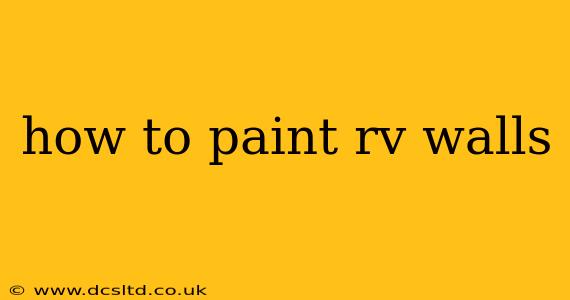Painting your RV walls can dramatically transform your living space, breathing new life into your motorhome or travel trailer. Whether you're aiming for a cozy cabin feel or a sleek, modern aesthetic, this guide will walk you through the process, ensuring a professional-looking finish that will last the journey.
Preparing Your RV Walls for Painting
Before you even think about touching a paintbrush, proper preparation is key to a successful paint job. This crucial step will ensure your paint adheres properly and lasts for years to come.
1. Cleaning the Walls: The Foundation of a Great Paint Job
Thoroughly clean your RV walls to remove dirt, grime, grease, and any existing wax or polish. Use a degreasing cleaner, following the manufacturer's instructions, and rinse thoroughly with clean water. Allow the walls to dry completely before proceeding. This is arguably the most important step. Skipping it will lead to poor paint adhesion and a less-than-perfect finish.
2. Repairing Imperfections: Addressing Scratches and Dents
Inspect your walls carefully for any imperfections, such as scratches, dents, or holes. Use a suitable filler to repair these, allowing it to dry completely and sanding it smooth with fine-grit sandpaper. This ensures a smooth, even surface for painting.
3. Priming for Adhesion: Creating the Perfect Base
Priming is essential, especially when painting over dark colors or surfaces with varying textures. A high-quality primer will create a uniform surface, improving paint adhesion and preventing the old color from bleeding through. Choose a primer specifically designed for use on RV walls or similar surfaces.
Choosing the Right Paint: Durability Meets Aesthetics
Selecting the right paint is crucial for a long-lasting, beautiful finish in your RV's often-challenging environment.
1. Type of Paint: Semi-Gloss or Satin?
Semi-gloss and satin paints are popular choices for RV walls. Semi-gloss offers excellent durability and easy cleaning, while satin provides a slightly softer sheen. Consider the level of sheen you prefer, balancing durability with the desired aesthetic.
2. VOC Content: Protecting Your Health and the Environment
Opt for low or zero-VOC (volatile organic compound) paints to minimize harmful fumes and ensure a healthier interior environment. Low-VOC paints are equally effective and kinder to your respiratory system.
3. Color Selection: Reflecting Your Personal Style
Choose a color that complements your RV's overall style and creates the atmosphere you desire. Consider using a lighter color to create a sense of spaciousness, particularly if your RV is smaller.
The Painting Process: Step-by-Step Instructions
With preparation complete and your paint selected, it's time to get painting!
1. Applying the Paint: Even Coats for a Professional Finish
Using a high-quality paint roller and brush, apply thin, even coats of paint, working in sections. Don't overload your brush or roller, as this can lead to drips and uneven coverage.
2. Multiple Coats: Ensuring Full Coverage and Rich Color
Two coats of paint are usually necessary for complete coverage and a rich, even color. Allow each coat to dry completely before applying the next. Follow the drying time recommendations on your paint can.
3. Cleaning Up: Maintaining a Clean Workspace
Clean your brushes and rollers immediately after painting with the appropriate thinner or cleaner recommended by the paint manufacturer. This will prevent the paint from hardening and ruining your tools.
Addressing Frequently Asked Questions
Here are some common questions that arise when painting RV walls.
What kind of paint is best for RV walls?
As mentioned above, semi-gloss or satin paints are popular choices due to their durability and easy cleaning. Look for paints specifically designed for use on walls or surfaces similar to those found in RVs. Always prioritize low-VOC options for a healthier environment.
How do I prevent paint from peeling on RV walls?
Proper preparation is key. Ensure the walls are thoroughly cleaned and any imperfections are repaired before priming and painting. Using a quality primer and applying thin, even coats of paint will also help prevent peeling.
How long does RV wall paint take to dry?
Drying times vary depending on the paint, temperature, and humidity. Check the paint can for drying time recommendations, and always allow each coat to dry fully before applying the next.
Can I use regular wall paint on my RV walls?
While you might technically get away with it, using a paint formulated for high traffic/moisture situations (like RV paint) will dramatically increase the lifespan of your new paint job and the ease of cleaning. The difference in cost compared to the expense and labor of repainting far outweighs the cost of better quality paint.
How much paint will I need to paint my RV walls?
This depends on the size of your RV and the number of coats required. It's always best to purchase slightly more paint than you estimate to ensure you have enough to complete the job. Most paint stores can help you estimate the amount you’ll need.
By following these steps and choosing the right materials, you can successfully paint your RV walls, transforming your living space and enjoying the results for many happy travels to come! Remember that patience and attention to detail are key to achieving a professional, long-lasting finish.
